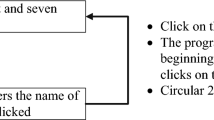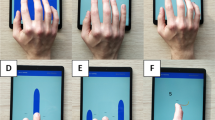Abstract
The rise in popularity of touchscreens supports the need for improving the usability and accessibility of the technology for users with varying abilities. Touchscreen activation methods (tapping, take-off) can help address these issues but may have trade-offs (longer time to complete task). This study evaluated tapping and take-off touchscreen activation methods during a multi-item selection activity. Participants with (n = 10) and without (n = 10) motor control disabilities affecting upper extremity function (+MCD and −MCD, respectively) completed an experimental task to select four items from a list using either tapping or take-off activation with two different levels of mental effort (memorization vs. no memorization). Fewer errors (29 vs. 21 %, p = .018) but longer task completion times (14.3 vs. 9.04 s, p = .007) were observed for take-off vs. tapping. Error rate doubled for memorization compared to no memorization (33.5 vs. 16.5 %, p = .002). Both +MCD and −MCD groups had fewer errors using the take-off method, but tapping was preferred, had fewer misses and required less task completion time during a menu selection activity. For tablet touchscreen menu selection applications for individuals with and without upper extremity motor control disabilities, take-off activation method is more accurate than tapping though tapping is preferred, has fewer misses and requires less task completion time. Additional mental demand leads to an increase in the number of errors during touchscreen operation.








Similar content being viewed by others
References
Schultz, K.L., Batten, D.M., Sluchak, T.J.: Optimal viewing angle for touch-screen displays: is there such a thing? Int. J. Ind. Ergon. 22(4), 343–350 (1998)
Wilson, K.S., Inderrieden, M., Liu, S.A. Comparison of five user interface devices designed for point-of-sale in the retail industry. In: Proceedings of the Human Factors and Ergonomics Society Annual Meeting, San Diego, CA, USA, pp 273–277 (1995)
Astell, A.J., Ellis, M.P., Bernardi, L., Alm, N., Dye, R., Gowans, G., Campbell, J.: Using a touch screen computer to support relationships between people with dementia and caregivers. Interact. Comput. 22(4), 267–275 (2010)
Newman, E.D., Lerch, V., Jones, J.B, Stewart, W.: Touchscreen questionnaire patient data collection in rheumatology practice: development of a highly successful system using process redesign. Arthritis Care Res. 64(4), 589–596 (2011)
Shervin, N., Dorrwachter, J., Bragdon, C., Shervin, D., Zurakowski, D., Malchau, H.: Comparison of Paper and computer-based questionnaire modes for measuring health outcomes in patients undergoing total hip arthroplasty. J. Bone Joint Surg. Am. 93(3), 285 (2011)
O’Donnell, B., Reith, R., Shirer, M.: Worldwide Smart Connected Device Market, Led by Samsung and Apple, Grew 27.1 % in the Third Quarter, According to IDC. International Data Corporation. Accessed July 9, 2013
Irwin, C.B., Sesto, M.E.: Performance and touch characteristics of disabled and non-disabled participants during a reciprocal tapping task using touch screen technology. Appl. Ergon. 43(6), 1038–1043 (2012)
Mertens, A., Jochems, N., Schlick, C.M., Dünnebacke, D., Dornberg, J.H.: Design pattern TRABING: touchscreen-based input technique for people affected by intention tremor. In: Proceedings of the 2nd ACM SIGCHI Symposium on Engineering Interactive Computing Systems. ACM, pp 267–272 (2010)
Lin, C.-J., Wu, C.: Reactions, accuracy and response complexity of numerical typing on touch screens. Ergonomics 56(5), 818–831 (2013)
Chen, K.B., Savage, A.B., Chourasia, A.O., Wiegmann, D.A., Sesto, M.E.: Touch screen performance by individuals with and without motor control disabilities. Appl. Ergon. 44(2), 297–302 (2013)
Chourasia, A.O., Wiegmann, D.A., Chen, K.B., Irwin, C.B., Sesto, M.E.: Effect of sitting or standing on touch screen performance and touch characteristics. Hum. Factors 55(4), 789–802 (2013)
Sesto, M.E., Irwin, C.B., Chen, K.B., Chourasia, A.O., Wiegmann, D.A.: Effect of touch screen button size and spacing on touch characteristics of users with and without disabilities. Hum. Factors 54(3), 425–436 (2012)
Colle, H.A., Hiszem, K.J.: Standing at a kiosk: effects of key size and spacing on touch screen numeric keypad performance and user preference. Ergonomics 47(13), 1406–1423 (2004)
Kim, J.H., Aulck, L., Thamsuwan, O., Bartha, M.C., Johnson, P.W.: The effect of key size of touch screen virtual keyboards on productivity, usability, and typing biomechanics. Hum. Factors 56(7), 1235–1248 (2014)
Bragdon, A., Nelson, E., Li, Y., Hinckley, K.: Experimental analysis of touch-screen gesture designs in mobile environments. Paper Presented at the Proceedings of the SIGCHI Conference on Human Factors in Computing Systems, Vancouver, BC, Canada (2011)
Guerreiro, T., Nicolau, H., Jorge, J., Gonçalves, D.: Towards accessible touch interfaces. Paper Presented at the Proceedings of the 12th International ACM SIGACCESS Conference on Computers and Accessibility, Orlando, FL, USA (2010)
Wacharamanotham, C., Hurtmanns, J., Mertens, A., Kronenbuerger, M., Schlick, C., Borchers, J.: Evaluating swabbing: a touchscreen input method for elderly users with tremor. Paper Presented at the Proceedings of the SIGCHI Conference on Human Factors in Computing Systems, Vancouver, BC, Canada (2011)
Wobbrock, J.O.: Goal crossing with mice and trackballs for people with motor impairments: performance, submovements, and design directions. ACM Trans. Access Comput. Univ. Wash. (2008). doi:10.1145/1361203.1361207
Potter, R.L., Weldon, L.J., Shneiderman, B.: Improving the accuracy of touch screens: an experimental evaluation of three strategies. In: Paper presented at the Proceedings of the SIGCHI Conference on Human Factors in Computing Systems, Washington, DC, USA (1988)
Hockey, G.R.: Compensatory control in the regulation of human performance under stress and high workload; a cognitive-energetical framework. Biol. Psychol. 45(1–3), 73–93 (1997)
Lansdown, T.C.: Individual differences during driver secondary task performance: verbal protocol and visual allocation findings. Accid. Anal. Prev. 34(5), 655–662 (2002)
Lindenberger, U., Marsiske, M., Baltes, P. B., Memorizing while walking: increase in dual-task costs from young adulthood to old age. Psychol. Aging 15(3), 417 (2000)
Vanderheiden, G. C., Law, C., Kelso, D., EZ interface techniques for anytime anywhere anyone interfaces. In: CHI'99 Extended abstracts on human factors in computing systems (ACM, 1999), pp. 3–4
Guttentag, R.E.: Age differences in dual-task performance: procedures, assumptions, and results. Dev. Rev. 9(2), 146–170 (1989)
Barroso, M.P., Arezes, P.M., da Costa, L.G., Sérgio Miguel, A.: Anthropometric study of Portuguese workers. Int. J. Ind. Ergon. 35(5), 401–410 (2005)
Hart, S.G., Staveland, L.E.: Development of NASA-TLX (Task Load Index): results of empirical and theoretical research. In: Hancock, P.E., Meshkati, N. (eds.) Human mental workload. Advances in psychology, vol. 52, pp. 139–183. Noth-Holland Press, Amsterdam (1988)
Jette, A.M.: Functional Status Index: reliability of a chronic disease evaluation instrument. Arch. Phys. Med. Rehabil. 61(9), 395–401 (1980)
Jette, A.M.: The functional status index: reliability and validity of a self-report functional disability measure. J. Rheumatol. 14, 15–21 (1987)
Guerreiro, T.: Towards accessible touch interfaces. In: ASSETS ‘10, Orlando, FL, USA (2010)
Seeberger, L.C.: Cerebellar tremor—definition and treatment. Colo. Neurol. Inst. Rev. 2005, 29–33 (2005)
Krigger, K.W.: Cerebral palsy: an overview. Am. Fam. Physician 73(1), 91–100 (2006)
Elble, R.J., Higgins, C., Leffler, K., Hughes, L.: Factors influencing the amplitude and frequency of essential tremor. Mov. Disord. 9(6), 589–596 (1994)
Manto, M.-U.: The wide spectrum of spinocerebellar ataxias (SCAs). Cerebellum 4(1), 2–6 (2005)
Lunn, M.R., Wang, C.H.: Spinal muscular atrophy. Lancet 371(9630), 2120–2133 (2008)
Thomas, C., Zaidner, E., Calancie, B., Broton, J., Bigland-Ritchie, B.: Muscle weakness, paralysis, and atrophy after human cervical spinal cord injury. Exp. Neurol. 148(2), 414–423 (1997)
Keates, S., Robinson, P.: Gestures and multimodal input. Behav. Inf. Technol. 18(1), 36–44 (1999)
Keates, S., Langdon, P., Clarkson, P.J., Robinson, P.: User models and user physical capability. User Model. User Adap. 12(2), 139–169 (2002)
Acknowledgments
The contents of this paper were developed with funding from the National Institute on Disability and Rehabilitation Research, U.S. Department of Education, Grant Number H133E080022 (RERC on Universal Interface & Information Technology Access). However, those contents do not necessarily represent the policy of the Department of Education, and you should not assume endorsement by the Federal Government.
Author information
Authors and Affiliations
Corresponding author
Rights and permissions
About this article
Cite this article
Chourasia, A., Sesto, M., Kuehn, K. et al. Effects of activation method and mental effort on touchscreen task performance for users with and without upper extremity motor control disabilities. Univ Access Inf Soc 16, 469–481 (2017). https://doi.org/10.1007/s10209-016-0471-2
Published:
Issue Date:
DOI: https://doi.org/10.1007/s10209-016-0471-2




